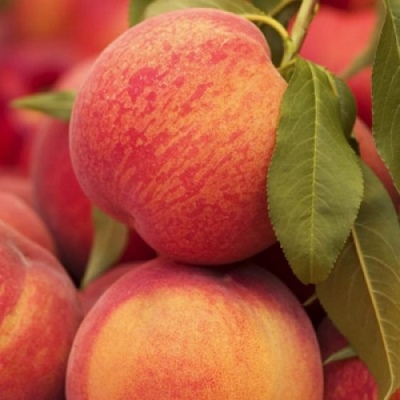
- Authors: Canada
- Appeared when crossing: Redskin x Harbinger
- Growth type: vigorous
- Ripening period: early
- Appointment: for fresh consumption, for canning
- Yield: fruitful
- Marketability: high
- Transportability: high
- Separability of the bone from the pulp: good
- Winter hardiness: very high
Lovers of peaches can pamper themselves with delicious fruits every year if they plant a peach tree on the site. One of the popular species is the early Harrow Diamond.
Breeding history
Harrow Diamond is a popular Canadian selection created by scientist Richard Lane in 1970. A culture was obtained by crossing Redskin and Harbinger varieties. Peach was introduced and registered as a variety in 1984. Due to its frost resistance, the Canadian variety can grow productively in the Central region and, of course, in the southern part of Russia.
Description of the variety
The Canadian peach is a vigorous tree with a moderately spreading crown that is not heavily thickened with glossy emerald green leaves. Under favorable conditions, the tree gains a height of up to 4 meters.
The peach blooms quite early: late April - early May. At this time, the crown is literally covered with large light flowers, emitting a bright aroma.
Fruit characteristics
Harrow Diamond is a representative of medium-sized varieties. With proper care, the tree grows fruits weighing 140-150 grams or more. The shape of the fruit is elongated-rounded with a pronounced narrowing at the apex. A ripe peach has a pale orange color, diluted with a carmine-burgundy blush that covers 60-70% of the fruit surface. The peel of the fruit is thin, dryish, velvety, with a barely noticeable edge. The abdominal suture is poorly expressed.
The harvested crop is easily transported and stored for some time without loss of marketable quality and useful properties. The purpose of fruits is universal - eating fresh, using in cooking, processing into jam and compotes, canning with slices.
Taste qualities
The taste of peaches is memorable and bright. Light orange pulp, turning pink closer to the stone, is characterized by a delicate, fleshy, slightly fibrous and very juicy structure. The fruit has a harmonious taste - sweet, with a spicy sourness, without astringency. A peculiarity of the variety is its incredible dessert-fruit aroma, which does not get lost even after processing. The stone separates well from the pulp.
Ripening and fruiting
The Canadian peach is early maturing. The tree begins to bear fruit in the 3-4th year after planting a one-year seedling. You can taste fruits in the first decade of July. The peak of ripening and fruiting occurs at the end of July - beginning of August. The fruits are spiced together. Peaches can stay on the tree for about 10 days without crumbling. The tree's productivity is 25-30 years.
Yield
The variety is declared to be fruitful. A characteristic feature is an increase in yield indicators as the tree matures. In the first years of fruiting, you can count on 20-25 kg per season from one tree, but after 5-6 years the figure will grow to 50 kg.
Self-fertility and the need for pollinators
The peach tree is self-fertile, so it does not need pollinating varieties. Some farmers are confident that planting donor trees nearby has a positive effect on the dynamics of yield, even for self-fertile crops.
Growing and caring
Saplings are planted in spring (from March to May) and in autumn (from September to October).It is necessary to plant on a flat, weed-free area, preferably in the southern part, so that the tree gets a lot of light and heat, while there is protection from drafts. The distance between plantings should be at least 2 meters. One-two-year-old seedlings are considered the best, as they take root faster.
Agrotechnics of the tree include: regular watering (3-4 times per season), fertilization (spring and autumn feeding), loosening and mulching of the near-stem zone, crown formation, regular pruning of branches, thinning, disease prevention. In addition, do not forget about whitewashing the trunk and normalizing the ovaries.



Frost resistance and the need for shelter
The Harrow Diamond variety is winter-hardy, therefore it easily tolerates temperature drops to -25 ... 28 degrees. The tree is also not afraid of recurrent spring frosts. Peach trees growing in the northern regions need shelter for the winter.
Disease and pest resistance
The fruit crop has high immunity, which prevents infection with powdery mildew, clotterosporia and bacteriosis. With proper care and timely prevention, the tree will not be exposed to many diseases and attacks of insect pests.

Requirements for soil and climatic conditions
The tree grows comfortably on medium loamy soils with the following characteristics - air permeability, looseness, fertility, moisture, neutral acidity. It is important that the passage of groundwater is deep, which will prevent stagnation of moisture, which will negatively affect the root system.
































































